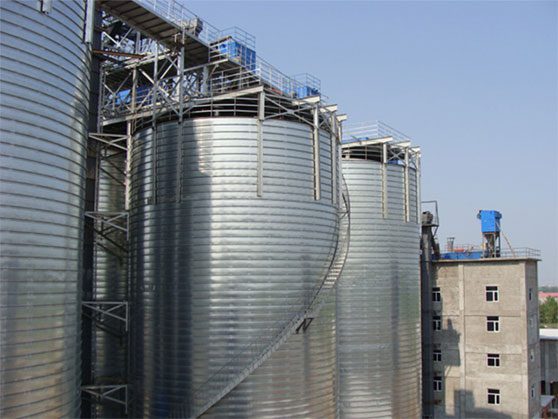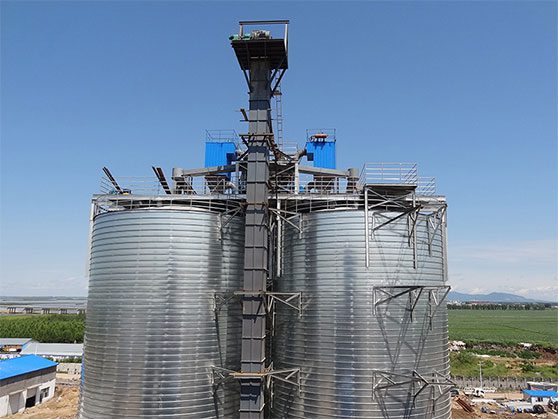The cement silo, also known as cement container or cement storage silo, is widely used in cement production plants to store cement.
The steel silo is a spiral silo with outstanding performance, built using unique manufacturing methods, professional equipment, and mechanized operations.

Cement silos play an important role in the cement industry chain. They can effectively improve the transportation efficiency of cement. Furthermore, they reduce transportation costs and ensure the quality and safety of the cement.
Structure
セメントサイロ is one of the most common kinds of spiral steel silo. There are 3 parts: silo roof(also called silo top), silo body and silo bottom.
Silo roof includes cover board, purline, platform, upper ring, under ring, feeding hole, air hole, safety fence and Skirting board.
Silo body includes silo shell/ steel plate, reinforcing rib and reinforcing rib connecting plate, silo door/manhole, and spiral ladder outside silo.

System Introduction
This system generally includes: cement feeding system, silo aeration system, cement discharging system, bulk truck loader system, bag packing system, packed bag palletiser or truck loading system, dust collector system, PLC control system, and related steel structures and platforms. usually our technical can design the whole cement silo system according to customer's requirement.
Low Initial Investment: By adopting various patented technologies, the process saves about 50% of building materials and more than 60% of the land required.
Good Air Tightness: The patented vacuum sealing technology maintains the physical indexes of cement quality. It keeps these indexes essentially unchanged for up to 9 months of storage inside the silo.
Energy Saving and Environmental Protection: The process of silo feeding and discharging uses patented dust removal technology, preventing pollution to the surrounding environment.
Long Service Life: With the standard maintenance,service life is up to 30-50 years.
Short Construction Period: Help the clients to put into use and recoup funds quickly.
Light Weight: The silo has low weight,which greatly reduces the load and cost of the foundation structure.

Principle
1. Storage and Sealing:
-
- The silo features a sealed design to protect the stored material from environmental factors such as moisture and contamination.
2. Level Detection:
-
- Equipped with level sensors, the silo continuously monitors the amount of cement stored. These sensors provide real-time data on material levels, ensuring efficient inventory management.
3. Material Flow:
-
- When cement is needed, it flows from the bottom of the silo through a discharge system, often involving a screw conveyor or aeration system. This ensures a consistent and controlled release of material.
4. Aeration:
-
- To facilitate the flow of cement, aeration systems may be used. These systems introduce air into the silo, reducing friction and helping to prevent material from clumping.
5. Transportation:
-
- Once discharged, cement can be transported via pneumatic systems, screw conveyors, or other methods to various locations, such as mixing plants or construction sites.
6. Safety Features:
-
- Darko designs silos with safety measures, including pressure relief valves and emergency shut-off systems, to manage the risks associated with high-pressure conditions and prevent accidents.

Structural analysis






